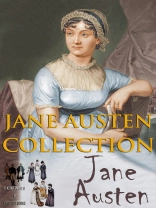This Excellent Collection brings together Jane Austen’s longer, major books and a fine selection of shorter pieces and Fiction Books. These Books created and collected in Jane Austen’s Most important Works illuminate the life and work of one of the most individual writers of the XIX and XX century – a woman who elevated political writing to an art.
Jane Austen (16 December 1775 – 18 July 1817) was an English novelist known primarily for her six major novels, which interpret, critique and comment upon the British landed gentry at the end of the 18th century. Austen’s plots often explore the dependence of women on marriage in the pursuit of favourable social standing and economic security. Her works critique the novels of sensibility of the second half of the 18th century and are part of the transition to 19th-century literary realism. Her use of biting irony, along with her realism, humour, and social commentary, have long earned her acclaim among critics, scholars, and popular audiences alike.
While not widely known in her own time, Jane Austen’s comic novels of love among the landed gentry gained popularity after 1869, and her reputation skyrocketed in the 20th century. Her novels, including Pride and Prejudice and Sense and Sensibility, are considered literary classics, bridging the gap between romance and realism.
This Collection included:
1. Lady Susan
2. Sense and Sensibility
3. Pride and Prejudice
4. Mansfield Park
5. Emma
6. Persuasion
7. Northanger Abbey
8. Juvenilia – Volume I
9. Juvenilia – Volume II
10. Juvenilia – Volume III
Tentang Penulis
The seventh child and second daughter of Cassandra and George Austen, Jane Austen was born on December 16, 1775, in Steventon, Hampshire, England. Austen’s parents were well-respected community members. Her father served as the Oxford-educated rector for a nearby Anglican parish. The family was close and the children grew up in an environment that stressed learning and creative thinking. When Austen was young, she and her siblings were encouraged to read from their father’s extensive library. The children also authored and put on plays and charades. Over the span of her life, Austen would become especially close to her father and older sister, Cassandra. Indeed, she and Cassandra would one day collaborate on a published work. To acquire a more formal education, Austen and Cassandra were sent to boarding schools during Austen’s pre-adolescence. During this time, Austen and her sister caught typhus, with Austen nearly succumbing to the illness. After a short period of formal education cut short by financial constraints, they returned home and lived with the family from that time forward.Literary Works Ever fascinated by the world of stories, Austen began to write in bound notebooks. In the 1790s, during her adolescence, she started to craft her own novels and wrote Love and Freindship [sic], a parody of romantic fiction organized as a series of love letters. Using that framework, she unveiled her wit and dislike of sensibility, or romantic hysteria, a distinct perspective that would eventually characterize much of her later writing. The next year she wrote The History of England…, a 34-page parody of historical writing that included illustrations drawn by Cassandra. These notebooks, encompassing the novels as well as short stories, poems and plays, are now referred to as Austen’s Juvenilia.Austen spent much of her early adulthood helping run the family home, playing piano, attending church, and socializing with neighbors. Her nights and weekends often involved cotillions, and as a result, she became an accomplished dancer. On other evenings, she would choose a novel from the shelf and read it aloud to her family, occasionally one she had written herself. She continued to write, developing her style in more ambitious works such as Lady Susan, another epistolary story about a manipulative woman who uses her sexuality, intelligence and charm to have her way with others. Austen also started to write some of her future major works, the first called Elinor and Marianne, another story told as a series of letters, which would eventually be published as Sense and Sensibility. She began drafts of First Impressions, which would later be published as Pride and Prejudice, and Susan, later published as Northanger Abbey by Jane’s brother, Henry, following Austen’s death.In 1801, Austen moved to Bath with her father, mother and Cassandra. Then, in 1805, her father died after a short illness. As a result, the family was thrust into financial straits; the three women moved from place to place, skipping between the homes of various family members to rented flats. It was not until 1809 that they were able to settle into a stable living situation at Austen’s brother Edward’s cottage in Chawton.Now in her 30s, Austen started to anonymously publish her works. In the period spanning 1811-16, she pseudonymously published Sense and Sensibility, Pride and Prejudice (a work she referred to as her ‘darling child, ‘ which also received critical acclaim), Mansfield Park and Emma.












